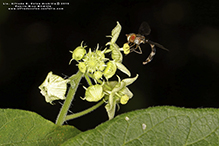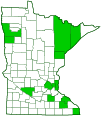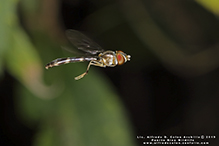eastern band-winged hover fly
(Hypocritanus fascipennis)
Conservation • Description • Habitat • Ecology • Distribution • Taxonomy
|
|
||||||||||||||
Description |
Eastern band-winged hover fly is medium-sized flower fly. It occurs in the United States east of the Great Plains, and across southern Canada. It is most common in the northeast and the upper Midwest. It is not common in Minnesota, where it is at the western extent of its range. Adults are found from early June to late September in forests, bogs, and marshes. They feed on flower nectar. Larvae feed on mealybugs and scale insects. Adults are dark, slender, and long, ⅜″ to ½″ (9.0 to 13.3 mm) in length. The head is large, round, and distinctly wider than the thorax. There are two large compound eyes on the sides of the head and three small simple eyes (ocelli) in a triangle on the top of the head. The compound eyes are brown and bare, with no erect hairs. On the male they meet at the top of the head. On the female they are narrowly separated, by about the width of the ocellar triangle. The face is entirely yellow. It is less than one-third as wide as the head and is short, not produced forward. The antennae are orange and short. They have just three segments and are inserted near the middle of the head when viewed from the side. The first and second segments are short. The third segment is oval. There is a stiff, forward-pointing bristle (arista) at the base of third segment. The arista are bare, not feather-like (plumose). The protruding mouthpart (proboscis) is short and fleshy. The thorax is short and black, with two pale longitudinal stripes. The plate between the thorax and abdomen (scutellum) is translucent and entirely or partially yellow, orange, or brown. The abdomen is long, narrow, and mostly black. It is three or four times as long as the thorax. There is an orange, yellowish, or whitish band at the base of the third and fourth segments. Each bands covers less than half of the segment. The wings are clear except for a brown patch at the base and a broad brown band in the middle that doesn’t reach the inner margin. There is a false vein (spurious vein) between the radius (R) and media (M) veins. The anal cell is long and is closed near the wing margin. The marginal, R5, and M2 cells are also closed. The R4+5 vein is nearly straight. |
Size |
Total length: ⅜″ to ½″ (9.0 to 13.3 mm) |
Similar Species |
Habitat |
Forests, bogs, and marshes |
Ecology |
Season |
Early June to late September |
Behavior |
|
Life Cycle |
|
Larva Hosts |
Mealybugs and scale insects |
Adult Food |
Flower nectar |
Distribution |
||
|
Sources Telford, Horace S.. (1939). The Syrphidae of Minnesota. University of Minnesota. Minnesota Agricultural Experiment Station. |
|
| 8/15/2025 | ||
Occurrence |
||
|
||
Taxonomy |
|
Order |
|
Suborder |
Brachycera |
Infraorder |
Cyclorrhapha |
Zoosection |
Aschiza |
Family |
Syrphidae (Hover Flies) |
Subfamily |
|
Tribe |
Syrphini |
Genus |
Hypocritanus |
This species was formerly placed in the genus Ocyptamus. That genus was an assemblage of more than 200 species that clearly did not belong together. It included species with different evolutionary lineages (paraphyletic). The genus was scrutinized in a number of studies between 2011 and 2018. In 2018, the genus Ocyptamus was narrowly restricted. Former subspecies and species groups were elevated to species rank, but some clades remained as species groups within Ocyptamus sensu lato. An article published in 2020 resolved these “orphaned” species, placing them in five new genera. The former Ocyptamus fascipennis group is now Hypocritanus fascipennis. |
|
Subordinate Taxa |
|
|
|
Synonyms |
|
Baccha fenestratus Baccha fuscipennis Baccha lugens Ocyptamus fascipennis Ocyptamus longiventris Syrphus amissas Syrphus peas Syrphus radaca |
|
Common Names |
|
eastern band-winged hover fly |
|
Glossary
Arista
A large bristle on the upper side of the third segment of the antenna of a fly. Plural: aristae.
Ocellus
Simple eye; an eye with a single lens. Plural: ocelli.
Proboscis
The tube-like protruding mouthpart(s) of a sucking insect.
Scutellum
The exoskeletal plate covering the rearward (posterior) part of the middle segment of the thorax in some insects. In Coleoptera, Hemiptera, and Homoptera, the dorsal, often triangular plate behind the pronotum and between the bases of the front wings. In Diptera, the exoskeletal plate between the abdomen and the thorax.
Spurious vein
A longitudinal, thickened line between the radius and media veins. It resembles a true vein but is not connected to any other veins.
Visitor Photos |
||
Share your photo of this insect. |
||
This button not working for you? |
||
Alfredo Colon |
||
 |
||
Bill Reynolds |
 |
Syrphid |
MinnesotaSeasons.com Photos |
||
|
||

Slideshows |
|

Visitor Videos |
||
Share your video of this insect. |
||
This button not working for you? |
||
|
Other Videos |
||
Syrphid Fly - Ocyptamus fascipennis |
About
Aug 29, 2018 Syrphid Fly ( Ocyptamus fascipennis ) Yorkville Silver Springs State Park, Kendall County, Illinois, USA August 19, 2018 Just trying to fill a void in video documentation of the Hover/Syrphid Flies in the Internet |
Ocyptamus fascipennis (famille des syrphes) butinant sur une fleur de bardane. |
About
Aug 15, 2019 Rivière Seine, Saint-Boniface (Mb). Caméra de cellulaire gratuit avec lentille macro à 5$. |

Created: 1/10/2021 Last Updated: © MinnesotaSeasons.com. All rights reserved. |




